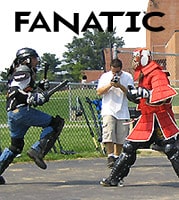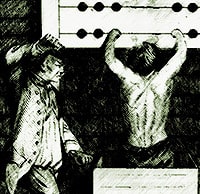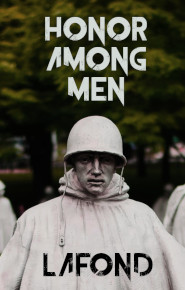Shared Traditions: Continued
-M. Grooming: Traditionally, modern gladiatorial orders wore hair and beard in a length intended to provide padding for their helmets. With the increase in gunpowder weapons, short military “crew cuts” and clean shaven faces have been adopted, with helmet liners employed for those few houses that go helmeted in military service and in the arena. Exceptions to this rule are: A Sagisarius wears his hair according to his tribal tradition. Hunters are permitted long hair and beards. Boxers and Rodmen wear hair cut to an inch above the brow and below the ear and prefer full beards to deaden facial blows.
-N. Hygiene is strict among all houses and requires military bathing schedules combined with prayers to the Holy Trinity, in the name of the Apostle named as the guiding light of that order.
-0. In antiquity, the lannista was the manger and task master of the gladiator, from his own house, who forced reluctant gladiators forward with whip and iron. Modern Christian orders have no lannista. That task, in the arena, is accomplished by a Lictor. See Appendix on Civic and Military Orders.
-P. Attire in the arena are limited to sandals, loincloth and girdle, which protects the groin, so much prized for slave breeding and by patrician dames.
The Six Crusading Orders also known as The High Houses
House: Equis, or Knights or Sarmations
Rank: 1st
Sacral Month: August
Patron Archangel: Saint Michael, Defender of the Faith
Guiding Apostle: Simon (Peter)
Bloodline: Romano-Breton, with Sarmation blond hair preferred
Colors: Gold
Brand: Cross in Nimbus
Religious Duty: Defense of Christendom
Military Duty: flanking foot to marry foot and horse in the line, storming breaches in the walls of forts, leading boarding parties
Civic Duty: Guard Augustus and Caesar
Traditional Arms: spatha [straight saber with no handguard] and shield with visored helmet
Military Arms: arming sword in the form of a tapering crucifix, a martial crucifix [an iron war hammer in the form of a cross with pointed arms and inverted half moon top for blade catching used in the off hand and as a boarding ax] visored helmet retained military service, a brace of 3 grenades, artillery—yes, gladiators with big guns.
Civic Arms: same as military
History: Inspired by the example of Arthur and his Circle of Sarmation Knights, the House Equis was formed in 1529 and fields the most feared combatants in Rome.
Glory: The storming and taking of Gibraltar from the Moorish Saracens in 1588. This citadel is held by the House Equis to the present day, the only Gladiatorial House to have its own fleet. The House Equis is the largest and most prestigious House Munera and is capable of fielding major military operations without the aid of the Navy or Army. The Bishop of Knights is sometimes styled the Eighth Caesar. Musketeers are provided by Nordic, German and Polynesian war slaves converted from the heathen on the promise to be freed after 30 years service. Horsemen are likewise drawn from Turkic, Tartar and Moorish Saracens according to the same religious and manumission arrangement.
Joe Equis, or Joe Knight or Sarmation Joe
House: Gladitorius or Gladiators or Swordsmen
Rank: 2nd
Sacral Month: Sepulcher
Patron Archangel: Saint Michael Protector of the Faith
Guiding Apostle: Andrew, Brother of Peter
Bloodline: Roman-Breton
Colors: Silver
Brand: Shield with Crucifix Boss
Religious Duty: Guarding Cathedrals
Military Duty: Garrisoning Fortified Positions and guarding supply trains and serving as sappers in sieges
Civic Duty: Train the Praetorians
Traditional Arms: gladius and scutumn, traditional shield of ancient Rome and open faced helmet with neck guard according to the ancient design
Military Arms: blunderbuss, gladius with crucifix hilt, pugio, breastplate, helmet with culverns mounted on carts and boats, the order having a fleet of open gunboats often operating as river patrols and coast guards
Civic Arms: rods and scutumns and breastplates are used to quell mob disturbances and raid mob hideouts in coordination with Lictor and Preatorian forces engaged in restoring and maintaining public order and fighting crime. Training of Praetorian Guard.
History: Formed in 1529 as a defensive garrison force in support of the House Equis, the House of Swords is the second largest of the Gladiatorial Houses.
Glory: Credited with defeating the Danish invasion of Britain at Kent in 1542. These men are regarded as superior to all other gladiator types in mixed arena combat.
Joe Gladiatorius, or Joe Gladiator, Joe of the Sword or Joey Sword or Sordid Joe by the mob who hate these men for their law enforcement role with an unequaled passion.
House: House Myrmillo or Marines
Rank: 3rd
Sacral Month: Spring
Patron Archangel: Saint Martial [formerly Mars and provisionally ranked among the Archangels by the Pope]
Guiding Apostle: James and John the Fisher Brothers
Bloodline: Romano-Breton, Cornish, Scottish or Nordic-Germanic Converts
Colors: Bronze
Brand: Fish-crested vizored helm
Religious Duty: Provide a full battalion in service to the Pope and directly subject to his orders
Military Duty: Naval boarding parties, opposed landings, naval sieges and island combat and garrison duty, with half of the order strength active in Oceanna. Train and lead sailors in combat.
Civic Duty: funeral processions under traditional arms, as the order is known for losing entire commands to recover slain comrades, even from besieged fortresses.
Traditional Arms: round shield and gladius with bronze helm
Military Arms: straight cutlass, brass boarding hat with bill, T-bar face cage and male coif, boarding ax, carbine and pistol
Civic Arms: the marine’s traditional arms, are regarded as the best street-fighting kit in Rome
History: Formed in 1530 to combat Nordic depredations, and expanded in 1541 to put down an Irish uprising, the Marines of Rome are resented by most other Houses and the Army, though they are in fast brotherhood to the Navy, who provide their transport. Each House Marine must field a company or battalion strength unit intended for combat. They engage in Christian arena combat the least, only accepting challenges from the House of Nets and never making challenges of their own. These gladiators are most likely to face heathen opponents in the arena and refuse to fight criminals, from whom they openly recruit to deplete their ravaged ranks.
Glory: Many acts of suicidal valor have been committed by the Marines. The most notorious was the siege of Sado Castle upon Sado Island west of Honshu when one of their sappers was captured and hung from a cross upon the battlement. The senseless frontal assaults that insured eventually freed that marine, though of his 5,000 fellows, only 31 remained alive. The city of Sado was put to the sword, except for the boys, who were inducted into the House Marine to fill the ranks left vacant by the slayers of their parents.
Joe Myrmillo, or Joe Marine, Fishy Joe, Joe Fish and “Jimmy-John” in honor of Christ’s third and fourth Apostles
House: Thrax or Thracian or Highlander or Scots
Rank: 4th
Sacral Month: Winter
Patron Archangel: Saint Michael the Protector
Guiding Apostle: Rather the Prophet John the Baptist
Bloodline: Scottish or Nordic-Germanic Convert [2]
Colors: Steel in a Spiked Nimbus
Brand: Basket-hilt Claymore and Spiked Targe
Religious Duty: transport, guarding and recovery of sacred relics, beginning with the raid on Jutland to recover the Silver Cross Taken from Clydesmoor Church in 1537.
Military Duty: raiding and urban warfare, street fighting
Civic Duty: strictly arena entertainers
Traditional Arms: sica [bent cutlass] and spiked shield with T-bared vizored helmet with mail coif
Military Arms: Claymore and Targe, hat and kilt, heavy pistol and dirk
Civic Arms: dirk and hawthorn knob-headed walking stick, awarded as a civic symbol after the order broke the Dubliner Rebels in the 1702 Uprising. This history has compelled the order to demand that its members are regarded as ever on civic patrol by the wearing of their helmet in public.
History: Formed in 1530 to combat Nordic depredations and infamous for their role in the crushing of numerous Irish uprisings. Thrax Houses are smaller, fielding squad-sized units for military service. Augustus Brittannicus, noting the similarity in ancient Thracian and modern Highlander equipment, named the house so.
Glory: This breed of man gained their longest lasting renown as the leading fighter type to drive the heathens of North and Arctic Pannonia off the Appalachian Mountains and beyond the Mississippi River and Great Lakes in the 200 years of Woodland Wars. Thracians are renown also for taking on daring individual missions for the clergy. They are infamous for imitating John the Baptist’s medium when questioning enemy captives or criminal suspects concerning the return of sacred artifacts, to include a simple parish wine cup that once cost the Entire Gang of Shives, a notorious New Your Mob, their lives at the hands of Preacher Thrax, infamous for quoting Scripture while interacting with those suspected of pilfering church artifacts, even as scanty as tin cup candles, penny boxes and Eucharist waifers taken by the starving.
Joe Thrax, or Thracian Joe, Joe Highlander, Joey Scott, Churchy Scott, or Jerry Joe or Viking Joe if he seems particularly Nordic
Note 2: the conversion of such Nordic and Germanic captives and POWs constitutes a deliberate attempt to breed continental European genetics into Roman bloodlines. These men are most often put to stud service.
House: Retiarius or Boarder or Netman or Catcher
Rank: 5th
Sacral Month: Caesar
Patron Archangel: Uriel Pillar of Divine Strength
Guiding Apostle: Phillip
Bloodline: any
Colors: Navy blue
Brand: Net and Trident
Religious Duty: to battle heretics and Saracens in the arena, netted for conversion or skewered for blasphemy
Military Duty: all trained as swimmers and divers, small teams are used for mining and counter mining harbors and for nightime infiltration of enemy ports and fortresses
Civic Duty: runaway capture and harbor salvage, inspecting merchant ships for smuggling and tariff violations. Despite being the best and most active urban slave catchers, these men pride themselves with delivering their quarry unharmed, and are not resented by their quarry, who they tend to engage in friendly banter, even promising to put in a good word with the master upon the slave’s return.
Traditional Arms: trident, net and dagger
Military Arms: garrote and dagger with nets sometimes employed for immobilizing defenders on a ship being boarded or cast down from a ship onto an enemy boat under oar
Civic Arms: net and dagger
History: Revived as a coast guard against Turkic raiders in the Irish see in 1576, these gladiators are often crowd favorites in the arena and are most likely to be liked by the mob.
Glory: Joe the Net, in 1925, saved seven iron workers from perishing in a flooded caisson during the building of the Brooklyn Bridge.
Joe Retiarus, or Border Joe, Netman Joe, Netty Joe or Catcher Joe
House: Prococatuer or Challenger
Rank: 6th
Sacral Month: Easter
Patron Archangel: Uriel Pillar of Divine Strength
Guiding Apostle: Bartholomew
Bloodline: any
Colors: white with black trim
Brand: white gladius on black field
Religious Duty: trial by combat versus successful Muslim champions
Military Duty: train the officer class in swordsmanship
Civic Duty: guards to patrician class, employed to neutralize mob leaders and hitmen
Traditional Arms: gladius and oblong shield with open face helmet
Military Arms: rapier, pistol and dagger, cape and tasseled beret
Civic Arms: same
History: This order was formed in the year 1775 in the wake of numerous assassinations of patricians by plebean radicals. They serve mainly as Patrician body guards and as the companions and instructors of army and naval officers, drawn fro this same class. Tribunes prefer these men as bodyguards. There is no unit organization among Challengers. The numbers of challengers operating out of each house is kept strictly secret. Once in his lifetime, every Challenger is sworn to serve as a champion for a pebean of good character beset by criminal conspiracy or challenged unjustly by a Patrician [this latter, whom he is barred by oath not to slay, but disarm]. This Decree was instituted in 1820 as a counter revolutionary measure by the Pope and Augustus.
Glory: Lester Challenger of the South Panonnian House Provocatuer in Lima Peru, seconded, successfully one plebean in every province of South, Central, North and Arctic Panonia between 1821 and 1864 and retired undefeated from the arena with 76 sword duels, 13 pistol duels and 16 arena combats against Saracens, all of whom had been victorious against Christian champions. There is a statue of Lester Challenger in the Forum of Augusta, where he passed from surgical complications after a successful, but fatal, pistol duel at age 59.
Joe Provocatuer, or Joe Challenger, nobody uses slang addresses such as “Joey Caper” [3] unless he wishes a visit from said person.
A whispered nickname for Challengers is “Caper” in reference to their white capes with black trim.











